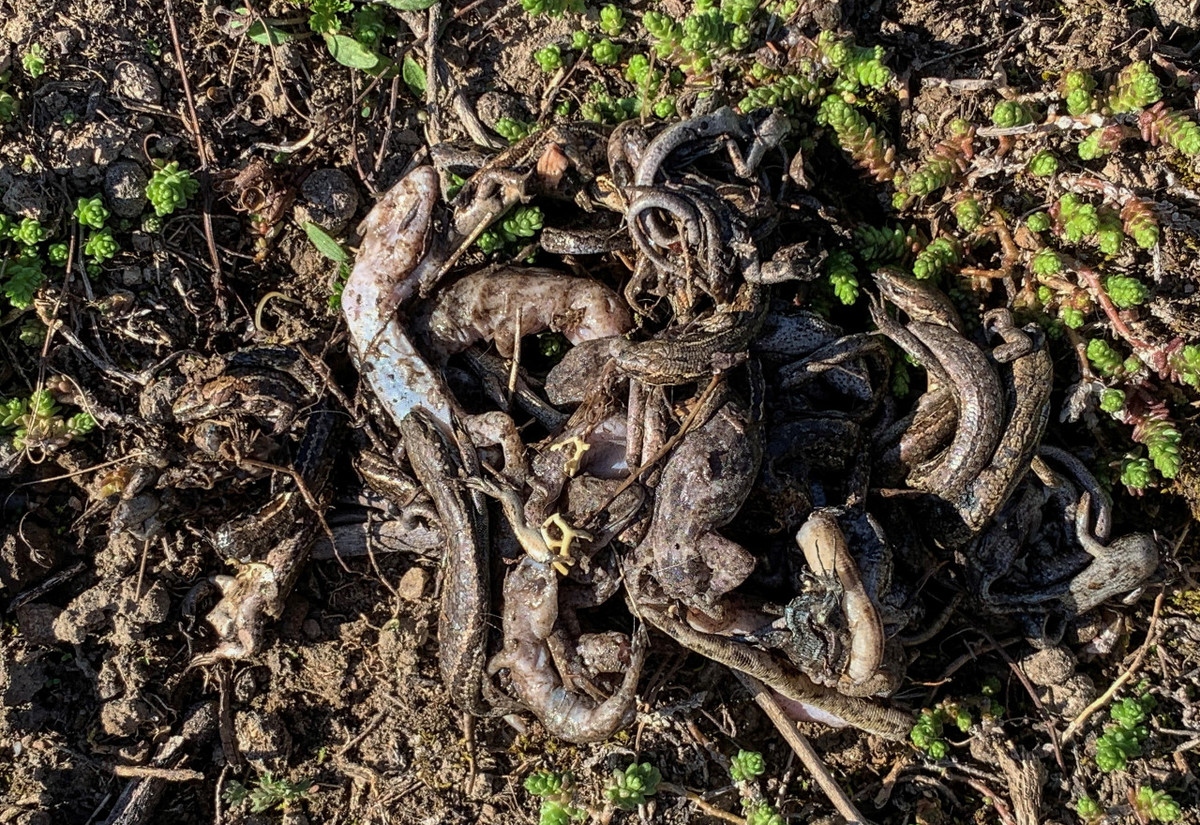Calls for tighter cat controls
Rowan Schindler
27 September 2021, 4:09 PM
 A pile of 28 regurgitated lizards was discovered on the edge of Alexandra sparking calls for tighter cat controls. Photo Joe Sherriff.
A pile of 28 regurgitated lizards was discovered on the edge of Alexandra sparking calls for tighter cat controls. Photo Joe Sherriff.Retired anaesthetist Joe Sherriff was out walking his dog when he saw something shiny and strange.
“I had a closer look, and realised it was a pile of dead lizards,” says Sherriff.
There were 28 lizards in the pile, a mixture of McCann’s skinks and schist geckos.
Sherriff contacted Dr Grant Norbury, a wildlife ecologist with Manaaki Whenua Landcare Research, who specialises in predator-prey dynamics.
“Given that it was a neat pile of lizards, with missing tails and puncture wounds, it looked like a cat had regurgitated its meal. Cats are known to cough up food if they’ve overdone it,” says Norbury.

A cat had killed, eaten and vomited up 21 McCann's skinks and seven schist geckos. Photo Joe Sherriff.
Norbury sent the photographs to several of his colleagues for their opinions, including DOC herpetologist Dr James Reardon. “It immediately looked like cat regurgitation to me, because the smaller predators chew up their prey more,” says Reardon.
Other herpetologists agreed. The fact the lizards were only minimally digested showed they were all eaten within several hours.
Professor Yolanda van Heezik is an urban ecologist at the University of Otago. “It’s not unlikely this was someone’s pet cat. It’s only 400m from the housing,” says van Heezik. Tracking studies show pet cats roam much further than their owners realise, about three hectares in the middle of town, and up to 28 hectares on the outskirts.

McCann's skink. Photo Carey Knox.
“Cat predation on our native wildlife is a really difficult issue, because cats are such important companion animals for many people,” says Norbury.
“Many people think their pet cats aren’t a problem. They think feral cats do that damage, and their pet cats don’t. But they do. They’ve got the same instincts, they’re hunters,” says Norbury. “Whether the culprit was a feral or pet cat, we have to acknowledge that pet cats are part of the problem for our wildlife.”
It’s such a problem because Aotearoa’s wildlife is incredibly special.
“A lot of New Zealanders don’t realise that we’ve got some of the most amazing lizards on the planet,” says Reardon. “But around a quarter are in imminent risk of extinction, and 90% are threatened to some degree by predation.”

Schist gecko, Alexandra. Photo: Carey Knox.
New Zealand is quite unusual in that we allow our cats, on the whole, to roam freely. “In Australia it’s more socially accepted to keep cats indoors, and not out hunting. And in large areas of America it’s the same,” says Reardon.
Van Heezik agrees. “They’re several decades ahead of us in terms of their thinking about cats. We need to embark on that journey.”
“We’re not saying don’t have a cat. But it’s about how you manage your cat to reduce harm to vulnerable wildlife,” says van Heezik.
“Ultimately, it would be best if people contained their cats 24/7.” This could be either inside the house or in a ‘catio’, a type of outdoor enclosure that’s common in North America and Australia.
“We already constrain our pedigree cats, which are considered too valuable to be allowed to roam in case they get injured, lost or impregnated by a non-pedigree tom.
“They’re very well looked after, and this could be the norm for all cats.”
Central Otago Ecological Trust’s Anna Yeoman, says cats are an important part of many people’s lives but constraints may need to come into force if the toll on wildlife continues.
“It seems that we need to change our norms around the way we keep them, and stop letting them roam,” Anna says. “And we need to do it quickly, together with the other efforts we’re making to control introduced predators, because if we don't we’ll lose some of these incredible animals forever.
“And I want my kids and grandkids to be able to enjoy our native lizards and birds.”


